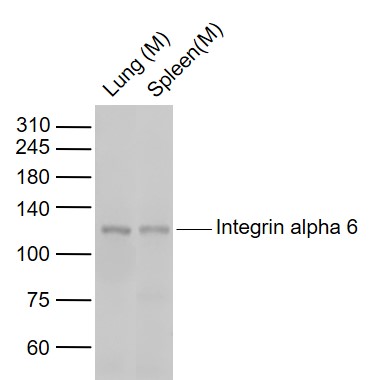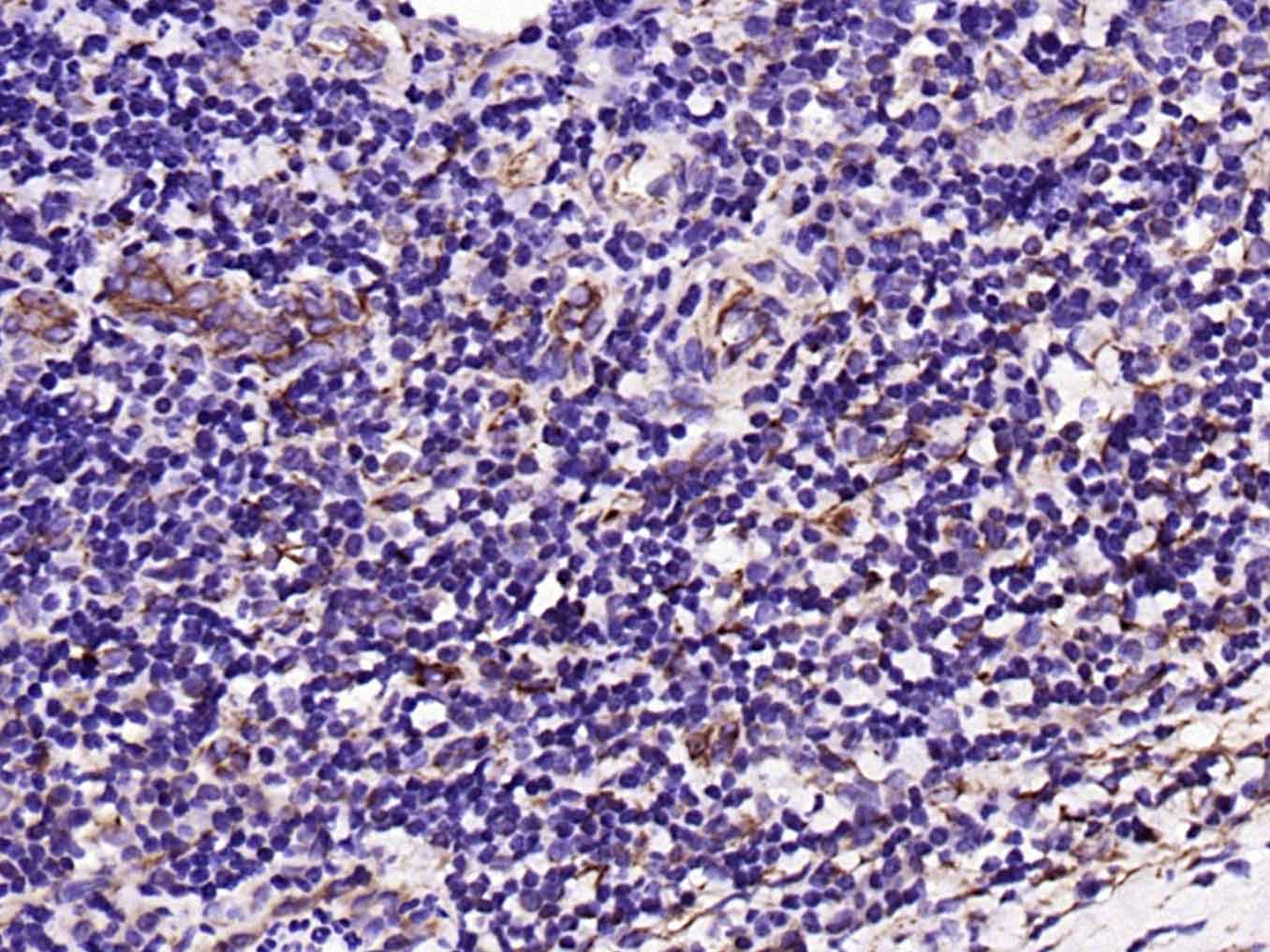
Rabbit Anti-Integrin alpha 6 antibody
Integrin alpha-6; Alpha6p; VLA 6 alpha subunit; VLA 6; VLA-6; Integrin α6; CD49 antigen-like family member F; CD49f; Integrin alpha6B; Integrin, alpha 6; ITA6_HUMAN; ITGA6; ITGA6B; Processed integrin alpha-6.
View History [Clear]
Details
Product Name Integrin alpha 6 Chinese Name 整合素α6(CD49f)Recombinant rabbit monoclonal anti Alias Integrin alpha-6; Alpha6p; VLA 6 alpha subunit; VLA 6; VLA-6; Integrin α6; CD49 antigen-like family member F; CD49f; Integrin alpha6B; Integrin, alpha 6; ITA6_HUMAN; ITGA6; ITGA6B; Processed integrin alpha-6. Research Area Cell biology immunology Signal transduction Stem cells Cell adhesion molecule lymphocyte Immunogen Species Rabbit Clonality Monoclonal Clone NO. 4F7 React Species Human, Mouse, (predicted: Rat, ) Applications WB=1:500-1000 IHC-P=1:50-200 IHC-F=1:50-200 (Paraffin sections need antigen repair)
not yet tested in other applications.
optimal dilutions/concentrations should be determined by the end user.Theoretical molecular weight 127kDa Cellular localization The cell membrane Form Liquid Concentration 1mg/ml immunogen Recombinant Human Integrin alpha 6: 1-100/1130 Lsotype IgG Purification affinity purified by Protein A Buffer Solution 0.01M TBS(pH7.4) with 1% BSA, 0.03% Proclin300 and 50% Glycerol. Storage Store at -20 °C for one year. Avoid repeated freeze/thaw cycles. The lyophilized antibody is stable at room temperature for at least one month and for greater than a year when kept at -20°C. When reconstituted in sterile pH 7.4 0.01M PBS or diluent of antibody the antibody is stable for at least two weeks at 2-4 °C. Attention This product as supplied is intended for research use only, not for use in human, therapeutic or diagnostic applications. PubMed PubMed Product Detail The gene encodes a member of the integrin alpha chain family of proteins. Integrins are heterodimeric integral membrane proteins composed of an alpha chain and a beta chain that function in cell surface adhesion and signaling. The encoded preproprotein is proteolytically processed to generate light and heavy chains that comprise the alpha 6 subunit. This subunit may associate with a beta 1 or beta 4 subunit to form an integrin that interacts with extracellular matrix proteins including members of the laminin family. The alpha 6 beta 4 integrin may promote tumorigenesis, while the alpha 6 beta 1 integrin may negatively regulate erbB2/HER2 signaling. Alternative splicing results in multiple transcript variants. [provided by RefSeq, Oct 2015]
Function:
Integrin alpha-6/beta-1 is a receptor for laminin on platelets. Integrin alpha-6/beta-4 is a receptor for laminin in epithelial cells and it plays a critical structural role in the hemidesmosome.
Subunit:
Heterodimer of an alpha and a beta subunit. The alpha subunit is composed of an heavy and a light chain linked by a disulfide bond. Alpha-6 associates with either beta-1 or beta-4. Interacts with HPS5. Interacts with RAB21.
Subcellular Location:
Cell membrane; Single-pass type I membrane protein.
Tissue Specificity:
Integrin alpha-6/beta-4 is predominantly expressed by epithelia. Isoforms containing segment X1 are ubiquitously expressed. Isoforms containing segment X1X2 are expressed in heart, kidney, placenta, colon, duodenum, myoblasts and myotubes, and in a limited number of cell lines; they are always coexpressed with the ubiquitous isoform containing segment X1. In some tissues (e.g. Salivary gland), isoforms containing cytoplasmic segment A and isoforms containing segment B are detected while in others, only isoforms containing one cytoplasmic segment are found (segment A in epidermis and segment B in kidney).
Post-translational modifications:
Isoforms containing segment A, but not segment B, are the major targets for PMA-induced phosphorylation. Phosphorylation occurs on 'Ser-1103' of isoform alpha-6X1X2A. Phosphorylation is not required for the induction of integrin alpha-6A/beta-1 high affinity but may reduce the affinity for ligand.
DISEASE:
Defects in ITGA6 are a cause of epidermolysis bullosa letalis with pyloric atresia (EB-PA) [MIM:226730]; also known as junctional epidermolysis bullosa with pyloric atresia (PA-JEB) or aplasia cutis congenita with gastrointestinal atresia. EB-PA is an autosomal recessive, frequently lethal, epidermolysis bullosa with variable involvement of skin, nails, mucosa, and with variable effects on the digestive system. It is characterized by mucocutaneous fragility, aplasia cutis congenita, and gastrointestinal atresia, which most commonly affects the pylorus. Pyloric atresia is a primary manifestation rather than a scarring process secondary to epidermolysis bullosa.
Similarity:
Belongs to the integrin alpha chain family.
Contains 7 FG-GAP repeats.
SWISS:
P23229
Gene ID:
3655
Database links:Entrez Gene: 3655 Human
Entrez Gene: 16403 Mouse
Omim: 147556 Human
SwissProt: P23229 Human
SwissProt: Q61739 Mouse
Unigene: 133397 Human
Unigene: 225096 Mouse
Product Picture
Lane 1: Lung (Mouse) Lysate at 40 ug
Lane 2: Spleen (Mouse) Lysate at 40 ug
Primary: Anti-Integrin alpha 6 (SLM-52265R) at 1/1000 dilution
Secondary: IRDye800CW Goat Anti-Rabbit IgG at 1/20000 dilution
Predicted band size: 120 kD
Observed band size: 120 kD
Paraformaldehyde-fixed, paraffin embedded (human tonsil); Antigen retrieval by boiling in sodium citrate buffer (pH6.0) for 15min; Block endogenous peroxidase by 3% hydrogen peroxide for 20 minutes; Blocking buffer (normal goat serum) at 37°C for 30min; Antibody incubation with (Integrin alpha 6) Monoclonal Antibody, Unconjugated (SLM-52265R) at 1:200 overnight at 4°C, followed by operating according to SP Kit(Rabbit) (sp-0023) instructionsand DAB staining.
References (0)
No References
Bought notes(bought amounts latest0)
No one bought this product
User Comment(Total0User Comment Num)
- No comment




 +86 571 56623320
+86 571 56623320
 +86 18668110335
+86 18668110335

